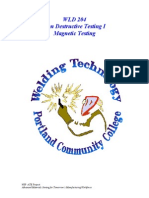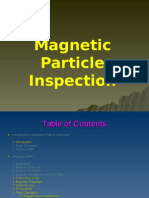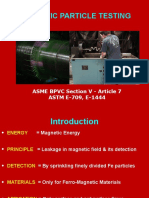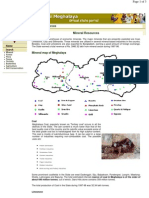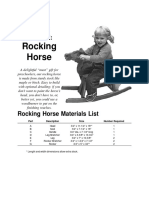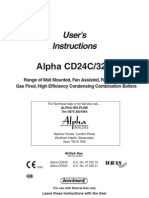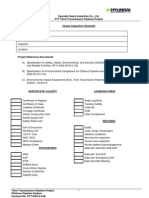Magnetic Particle Testing-1
Magnetic Particle Testing-1
Uploaded by
fiifiabakCopyright:
Available Formats
Magnetic Particle Testing-1
Magnetic Particle Testing-1
Uploaded by
fiifiabakOriginal Description:
Copyright
Available Formats
Share this document
Did you find this document useful?
Is this content inappropriate?
Copyright:
Available Formats
Magnetic Particle Testing-1
Magnetic Particle Testing-1
Uploaded by
fiifiabakCopyright:
Available Formats
MAGNETIC PARTICLE TESTING
Presentation by
Mohammed Hliyil Hafiz, PhD, P.E.
Assistant in Production and Metallurgy
Engineering Department
University of Technology,
Baghdad, Iraq.
Abstract
Magnetic particle methods are based on the collection of loose magnetic particles
at locations of magnetic flux leakage on an object. This phenomenon is familiar to almost
everyone from childhood experiments with magnets and iron filings.
Magnetic particle methods are based on surface or near surface discontinuities that
influence the electromagnetic properties of the object under test. For these methods to be
employed, the object under test must be electrically conductive and ferromagnetic.
Magnetic particle techniques thus allow the detection of surface-breaking cracks in steel
objects of complex geometry, which typically is a challenge for RT methods.
1-Implementation:
Magnetic particle testing (MPT) is a nondestructive method for locating cracks,
laps, seams, inclusions and other discontinuities on or near the surface of ferromagnetic
materials. MPT is based on the principle that the magnetic flux near the surface of a
magnetized material is distorted locally by the presence of discontinuities. This distortion
of the field pattern, or flux leakage, as illustrated in Figure 1, is capable of attracting
and holding an inspection medium of finely divided magnetic particles. Depending upon
the type particles used, they will be visible under the proper lighting condition.
Direct current (DC) and alternating current are both suitable for magnetizing parts
for MPT. The primary difference between the two currents is: the fields generated by DC
penetrate the cross section of the part, and the fields generated by the AC are confined to
the metal at or near the surface of the part. Therefore, AC should not be used for
subsurface discontinuities.
1-2--Practice:
Magnetic Particle Testing can be used on all ferromagnetic materials to locate
surface and subsurface discontinuities such as cracks, laps, seams, and inclusions.
1
1-3-Benefit:
Magnetic particle testing is a cost effective and expedient nondestructive Testing
(NDT) method for determining discontinuities in ferromagnetic material. This NDT
method can be performed in both the longitudinal and transverse directions.
The most common magnetization processes are circular and longitudinal. Circular
magnetization is when electric current is passed through a straight conductor creating a
circular magnetic field around the conductor. Longitudinal magnetization is when electric
current is passed through a coil of one or more turns a magnetic field is established within
the coil To form an indication, the magnetic field must approach a discontinuity at an
angle great enough to cause the magnetic field to leave the part and return after bridging
the discontinuity. Best results occur when the intersection is 45 degrees to 90 degrees to
the magnetic field lines. Magnetic particles may be applied
to surfaces in a dry form or they may be suspended in a water or oil carriers. The particles
are usually coated with a fluorescent material for easy visualization using a black light.
When using MPT makes sure the induced current is strong enough to produce the
magnetic field required to show the flaws being tested for. One fast method to insure
adequate current is the use of a field indicator. The field indicator consist of a metal
disk with cross hatch lines with a thin metal cover attached over the cross hatch disk
mounted on a yoke handle. This field indicator is placed in the magnetic field and the
current increased while adding magnetic particles until the magnetic particles form a
well-distinguished cross on the metal cover. There are also formulas in the references that
can be used to determine the starting current. The current can be adjusted as necessary to
obtain the desired magnetic field.
The advantages of using Magnetic Particle Testing are:
1. Complex shapes can be tested.
2. Cracks filled with paint or other foreign material can be detected.
3. Large numbers of similar parts can be rapidly tested /automated.
4. Small fine cracks can be detected.
5. Subsurface discontinuities can be located.
6. Cracks can be located through thin nonmetallic coatings.
7. Estimate crack depth.
8. Easily learned.
9. Relatively low cost.
The disadvantages of magnetic particle testing are:
1. Only ferromagnetic materials can be tested.
2. High electric current required to magnetize.
3. Demagnetization required in some instances.
4. Extreme care to avoid burn spots.
5. Difficult to detect small defects below the surface.
6. Cleaning required after test.
7. Complex shapes may require more than two magnetizations.
Material Safety Data Sheet (MSDS) should also detail personnel hazards such as
inhalation, skin contact and eye exposure. Magnetizing equipment should be properly
maintained to avoid personnel hazards from electrical shorts. Care should also be taken to
avoid electrical arcing and possible ignition of the oil carriers. Any broken ultraviolet
2
filters or bulbs should be replaced immediately. Personnel entering a darkened area to
perform fluorescent testing should wait at least one minute for their eyes to adjust to the
darkened area.
2-Technical Rational:
-MPT is a fast and cost-effective method for determining surface and subsurface defects
in ferromagnetic materials. The MPT techniques may be used for in-process inspection
and control, final inspection, receiving inspection and periodic maintenance of machines,
structures and handling equipment.
-Impact of Nonpractice:
Failure to detect defects in surface and subsurface areas of components could result in
failure of the components, failure of mission and in extreme cases loss of life.
3-Magnetic Particle Inspection, basics
The part is magnetized. Finely milled iron particles coated with a dye pigment
are then applied to the specimen. These particles are attracted to magnetic flux leakage
fields and will cluster to form an indication directly over the discontinuity. This
indication can be visually detected under proper lighting conditions.
3-1-Magnetisation
The part is magnetised using electromagnets or permanent magnets.
Done in two directions to find cracks with different orientation
After testing, the part must be de-magnitised.
3-2-Magnetic Particles
A-Dry magnetic particles come in a variety of colors. A color that produces a high
level of contrast against the background should be used.
B-Wet particles are typically supplied as visible or fluorescent.
3-3-Magnetic Particle Inspection, advantages
+Can detect both surface and near sub-surface defects.
+Can inspect parts with irregular shapes easily.
+Precleaning of components is not as critical as it is for some other inspection methods.
Most contaminants within a flaw will not hinder flaw detectability.
+Fast method of inspection and indications are visible directly on the specimen surface.
+Considered low cost compared to many other NDT methods.
+Is a very portable inspection method especially when used with battery powered
equipment.
3-4-Magnetic Particle Inspection, limitations
-Cannot inspect non-ferrous materials such as aluminum, magnesium or most stainless
steels.
-Inspection of large parts may require use of equipment with special power requirements.
Some parts may require removal of coating or plating to achieve desired inspection
sensitivity.
3
4
-Limited subsurface discontinuity detection capabilities. Maximum depth sensitivity is
approximately 15 mm (very large cracks perpendicular to the magnetisation direction
under ideal conditions).Normal detection depth is a few millimeters.
-Post cleaning, and post demagnetization is often necessary.
-Alignment between magnetic flux and defect is important
3-References:
1. Bray, Don E. and Don McBride: Nondestructive Testing Techniques, J ohn Wiley &
Sons, Inc., 1992.
2. McMaster, Robert C.: Nondestructive Testing Handbook, Volume II, The Ronald
Press Company, New York 1963.
3. Metals Handbook, Volume 17: Nondestructive Inspection and Quality Control,
pp. 89-128, ASM International, Metals Park, OH, 1989.
4. MIL-STD-1949A: Military standard, Magnetic Particle Inspection, May 1989.
5. MIL-STD-1907: Military Standard, Inspection, Liquid Penetrant and Magnetic
Particle,
Soundness Requirements for Materials, Parts and Weldments, March 1990.
6. MIL-I-83387: Military Specification, Magnetic Rubber Inspection Process, J uly
1987.
7. ASTM E 1444-93: Standard Practice for Magnetic Particle Examination, American
Society for Testing and Materials, 1916 Race St. Philadelphia, PA 18103.
8. MSFC-STD-1249: Standard NDE Guidelines and Requirements for Fracture Control
Programs, Marshall Space Flight Center, AL 35812, September 1985.
9. CT-6-3: Nondestructive Testing Magnetic Particles, Class Room Training
Handbook,Second Edition, Convair Division of General Dynamics, San Diego, CA 1977.
10. P1-4-3: Nondestructive Testing, Magnetic Particle, Programmed Instruction
Handbook, Fourth Edition, Convair Division of General Dynamics, 1977.
11. MIL-STD-410E: Military Standard, Nondestructive Testing Personnel Qualification
and Certification, J anuary 1991.
You might also like
- Prepware Questions GeneralDocument150 pagesPrepware Questions GeneralGustavo Nárez Jr.100% (1)
- Solenoid Actuators: Theory and Computational MethodsFrom EverandSolenoid Actuators: Theory and Computational MethodsRating: 3 out of 5 stars3/5 (1)
- Magnetic Particle InspectionDocument34 pagesMagnetic Particle InspectionSyed Tanveer100% (3)
- MPI ProcedureDocument50 pagesMPI Procedureshabbir626100% (1)
- MT Level II 08-12Document208 pagesMT Level II 08-12Tapan Kumar Nayak100% (5)
- Eddy Current TestingDocument2 pagesEddy Current Testingemir_delic28100% (1)
- BLD 102 TheoryPracticalBookDocument38 pagesBLD 102 TheoryPracticalBookdkaviti100% (1)
- Magnetic Particle TDocument5 pagesMagnetic Particle TsaravananjaiNo ratings yet
- Non Destructive Testing and Materials ME6019: Unit-2Document16 pagesNon Destructive Testing and Materials ME6019: Unit-2MECHANICAL SMCETNo ratings yet
- Magnetic Particle Inspection Training CourseDocument3 pagesMagnetic Particle Inspection Training Coursemohamed abdallaNo ratings yet
- 2021 Batch Nde Mid-2 QBDocument14 pages2021 Batch Nde Mid-2 QBtanushkatarichandraNo ratings yet
- Nondestructivetesting 180514185439Document113 pagesNondestructivetesting 180514185439mamillapalli sri harshaNo ratings yet
- 3.korzeniowski Magnetic ParticleDocument32 pages3.korzeniowski Magnetic ParticlenasrpkNo ratings yet
- Nondestructivetesting 180514185439Document88 pagesNondestructivetesting 180514185439mamillapalli sri harshaNo ratings yet
- Magnetic Particle TestingDocument7 pagesMagnetic Particle TestingAmzar KamilNo ratings yet
- Nondestructive Evaluation Techniques Mag Particle 2Document1 pageNondestructive Evaluation Techniques Mag Particle 2shailesh jhaNo ratings yet
- NAME:-Branch: - Topic: - SubjectDocument15 pagesNAME:-Branch: - Topic: - SubjectKeval PatelNo ratings yet
- Non Destructive Testing AutosavedDocument26 pagesNon Destructive Testing AutosavedBirondoNo ratings yet
- Magnetic Particle TestingDocument32 pagesMagnetic Particle TestingAtheena Paulson100% (1)
- Asnt MTPTDocument234 pagesAsnt MTPTpakostralNo ratings yet
- Magnetic Particle Testing of Aerospace Materials: Preferred Reliability PracticesDocument5 pagesMagnetic Particle Testing of Aerospace Materials: Preferred Reliability PracticesAymeeenNo ratings yet
- ME8097 NDT Unit 2 Class 5Document15 pagesME8097 NDT Unit 2 Class 5MICHEL RAJNo ratings yet
- Non Destructive Testing: CMR Institute of TechnologyDocument32 pagesNon Destructive Testing: CMR Institute of TechnologyrajNo ratings yet
- Introduction To Magnetic Particle Inspection: E-Mail Info@ndt - It WWW - Ndt.itDocument3 pagesIntroduction To Magnetic Particle Inspection: E-Mail Info@ndt - It WWW - Ndt.itmenodjiiNo ratings yet
- Magnetic Particle TestingDocument23 pagesMagnetic Particle Testingmanafl salhlNo ratings yet
- Magnetic Particle TestingDocument38 pagesMagnetic Particle Testingtbmari100% (2)
- Magnetic Particle Inspection MethodDocument31 pagesMagnetic Particle Inspection MethodSushant TiwariNo ratings yet
- Magnetic Particle Testing (MT)Document2 pagesMagnetic Particle Testing (MT)Syahmie AzreeNo ratings yet
- Mpi PresentationDocument195 pagesMpi Presentationqazi1250% (2)
- Gambar 1Document10 pagesGambar 1Mario HanamiciNo ratings yet
- KME-061 Unit-2. Magnet Particle TestingDocument56 pagesKME-061 Unit-2. Magnet Particle Testingabhip2041No ratings yet
- MPTDocument7 pagesMPTmuthuswamy77No ratings yet
- Non-Destructive Testing 03Document111 pagesNon-Destructive Testing 03Muhammad AbidinNo ratings yet
- Magnetic Particle InspectionDocument195 pagesMagnetic Particle InspectionAnand HariNo ratings yet
- Penetrant Testing (A) Suggest Suitable Method and Justify Why You Choose The MethodDocument6 pagesPenetrant Testing (A) Suggest Suitable Method and Justify Why You Choose The MethodImelda TiongNo ratings yet
- Magnetic Particle TestingDocument27 pagesMagnetic Particle TestingGanapathy VigneshNo ratings yet
- Unit 1-2 Mag. Particle TestingDocument37 pagesUnit 1-2 Mag. Particle TestingMohammed Fakhruddin Hasan NizamiNo ratings yet
- Magnetic Particle TestingDocument30 pagesMagnetic Particle TestingAlmahi Eltigani AhmedNo ratings yet
- Magnetic Particle TestingDocument1 pageMagnetic Particle TestingsivaNo ratings yet
- Non Destructive TestingDocument118 pagesNon Destructive Testingandini dini100% (1)
- Sub-Part Magnetic Particle TestingDocument36 pagesSub-Part Magnetic Particle TestingIris Garcia100% (2)
- Magnetic Particle Examination Art Tec NBDocument8 pagesMagnetic Particle Examination Art Tec NBMarjourie MaloofNo ratings yet
- 6 Magnetic - Intro Final 03092013 OK PDFDocument27 pages6 Magnetic - Intro Final 03092013 OK PDFankit7588No ratings yet
- Definition of Magnetic Particle TestingDocument44 pagesDefinition of Magnetic Particle Testingகோகுல் இராNo ratings yet
- Magnetic Particle TestingDocument3 pagesMagnetic Particle TestingEarl De La ChinaNo ratings yet
- Magnetic Particle Inspection - PresentationDocument37 pagesMagnetic Particle Inspection - PresentationzdenmanNo ratings yet
- Megnatic Partical Inspection TestDocument23 pagesMegnatic Partical Inspection TestTHE BBEASTNo ratings yet
- Magnetic Particle InspectionDocument3 pagesMagnetic Particle InspectiontrollforgeNo ratings yet
- MPTDocument78 pagesMPThash117No ratings yet
- MTDocument65 pagesMTIkram SyedNo ratings yet
- New Sensors and Processing ChainFrom EverandNew Sensors and Processing ChainJean-Hugh ThomasNo ratings yet
- Nanocomposites: In Situ Synthesis of Polymer-Embedded NanostructuresFrom EverandNanocomposites: In Situ Synthesis of Polymer-Embedded NanostructuresLuigi NicolaisNo ratings yet
- Mathematical Analysis of Quasi-Simultaneous Laser Welding on PolymersFrom EverandMathematical Analysis of Quasi-Simultaneous Laser Welding on PolymersNo ratings yet
- Guidelines for the Determination of Standardized Semiconductor Radiation Hardness ParametersFrom EverandGuidelines for the Determination of Standardized Semiconductor Radiation Hardness ParametersNo ratings yet
- An Essential Guide to Electronic Material Surfaces and InterfacesFrom EverandAn Essential Guide to Electronic Material Surfaces and InterfacesNo ratings yet
- By: Uncle Ato Key F:: H Nbrayi B yDocument2 pagesBy: Uncle Ato Key F:: H Nbrayi B yfiifiabak100% (5)
- Carols Kings Oos 2021bDocument44 pagesCarols Kings Oos 2021bfiifiabak100% (1)
- HoughtonDocument1 pageHoughtonfiifiabakNo ratings yet
- AllThingsPraiseThee LaudantOmniDocument1 pageAllThingsPraiseThee LaudantOmnifiifiabakNo ratings yet
- Twenty-Five Free Hymn Harmonizations For Organ Set 1Document37 pagesTwenty-Five Free Hymn Harmonizations For Organ Set 1fiifiabakNo ratings yet
- Business Letter Writing: Every Letter Is A Sales Letter!Document9 pagesBusiness Letter Writing: Every Letter Is A Sales Letter!fiifiabakNo ratings yet
- Lewis Dot Notation Ionic Bonds Covalent Bonds Polar Covalent Bonds Lewis Dot Notation Revisited ResonanceDocument10 pagesLewis Dot Notation Ionic Bonds Covalent Bonds Polar Covalent Bonds Lewis Dot Notation Revisited ResonancefiifiabakNo ratings yet
- Lewis Dot Notation Ionic Bonds Covalent Bonds Polar Covalent Bonds Lewis Dot Notation Revisited ResonanceDocument10 pagesLewis Dot Notation Ionic Bonds Covalent Bonds Polar Covalent Bonds Lewis Dot Notation Revisited ResonancefiifiabakNo ratings yet
- Ridley 2001Document39 pagesRidley 2001fiifiabakNo ratings yet
- All About Pectin For Jam MakersDocument2 pagesAll About Pectin For Jam MakersfiifiabakNo ratings yet
- Part One - The Structure of AtomsDocument11 pagesPart One - The Structure of AtomsfiifiabakNo ratings yet
- To Improve and Speed Up The Application Process Please Fill Out This FormDocument1 pageTo Improve and Speed Up The Application Process Please Fill Out This FormfiifiabakNo ratings yet
- 11 June, 2014 Management Information Systems (3) 1Document36 pages11 June, 2014 Management Information Systems (3) 1fiifiabakNo ratings yet
- Creation of AgencyDocument16 pagesCreation of AgencyfiifiabakNo ratings yet
- Dishwasher: Group 6Document42 pagesDishwasher: Group 6Mixengxeng Ü EspinosaNo ratings yet
- Reactors and Separations Design Project Production of CumeneDocument7 pagesReactors and Separations Design Project Production of CumeneAli RahimiNo ratings yet
- BASF Formic Acid For The Rubber IndustryDocument8 pagesBASF Formic Acid For The Rubber IndustryalfinNo ratings yet
- Investigatory Project (Clay As Source of Electricity)Document13 pagesInvestigatory Project (Clay As Source of Electricity)jhozepmendoza83% (6)
- Bsi 1387 Scrwed PipesDocument26 pagesBsi 1387 Scrwed PipesSur SurNo ratings yet
- Y49146 Ee00 ST Spe 00034 - 03Document25 pagesY49146 Ee00 ST Spe 00034 - 03tho03103261No ratings yet
- Minerals in MeghalayaDocument3 pagesMinerals in MeghalayaDilip Gajanan Namjoshi100% (1)
- Staff Car Rules NDP 4.75Document2 pagesStaff Car Rules NDP 4.75satender kumarNo ratings yet
- IS 802 Part-1 (2) :1992Document16 pagesIS 802 Part-1 (2) :1992Sardar. Vikramjit Singh RandhawaNo ratings yet
- Construction and Building Materials: Phuong Trinh Bui, Yuko Ogawa, Kenichiro Nakarai, Kenji KawaiDocument7 pagesConstruction and Building Materials: Phuong Trinh Bui, Yuko Ogawa, Kenichiro Nakarai, Kenji KawaiMarden Rengifo RuizNo ratings yet
- 57 Palmstrom On Engineering Geology in NorwayDocument16 pages57 Palmstrom On Engineering Geology in NorwayvkarayanadathNo ratings yet
- Kerja-Kerja Menaiktaraf Sistem Telemetry Serta Kerja-Kerja Berkaitan Di Kawasan Pengairan Iada Barat Laut SelangorDocument3 pagesKerja-Kerja Menaiktaraf Sistem Telemetry Serta Kerja-Kerja Berkaitan Di Kawasan Pengairan Iada Barat Laut SelangorHarith FadhilaNo ratings yet
- Wood Working Plans - Toys - Rocking Horse PDFDocument6 pagesWood Working Plans - Toys - Rocking Horse PDFBen GerezNo ratings yet
- Salman Latiwala - Types of GlassDocument12 pagesSalman Latiwala - Types of GlassSalman LatiwalaNo ratings yet
- SynchromeshDocument7 pagesSynchromeshZein ElserfyNo ratings yet
- Filter Integrity Test MachineDocument4 pagesFilter Integrity Test MachineAtul SharmaNo ratings yet
- Alpha Bolier Cd32c ManualDocument8 pagesAlpha Bolier Cd32c Manualauto44298No ratings yet
- 9 Stang Catalog Deluge PDFDocument2 pages9 Stang Catalog Deluge PDFalfreddieick1No ratings yet
- MSDS-RS 33Document6 pagesMSDS-RS 33hui19yun89No ratings yet
- Review 2Document36 pagesReview 2Naishitha reddyNo ratings yet
- Section 16 QuestionsDocument5 pagesSection 16 QuestionsSameer Mohammad100% (1)
- GEA - Bock - SemiHerm - Catalogue - GB 48Document1 pageGEA - Bock - SemiHerm - Catalogue - GB 48hadi mehrabiNo ratings yet
- KBL CatalogDocument16 pagesKBL CatalogMunish Vashistha100% (1)
- 1-Above Ground Tank LiningDocument9 pages1-Above Ground Tank Liningmehdi abdianNo ratings yet
- AC Duct Design PDFDocument6 pagesAC Duct Design PDFkumar123rajuNo ratings yet
- Vessel Inspection ChecklistDocument4 pagesVessel Inspection Checklisthiyeon33% (3)
- Norma SimonsDocument24 pagesNorma SimonsJUAN PABLO LUCERONo ratings yet
- Solid Waste OrdinanceDocument23 pagesSolid Waste OrdinanceMiamor NatividadNo ratings yet
- PRC 5002 CurrentDocument9 pagesPRC 5002 CurrentJaroslaw KoniecznyNo ratings yet



